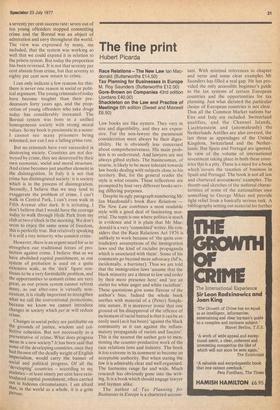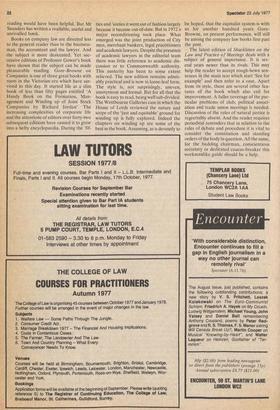The fine print
Hubert Picarda
Race Relations — The New Law Ian Macdonald (Butterworths £14.50) Tax Planning for Businesses in Europe M. Roy Saunders (Butterworths £12.00) Gore-Brown on Companies 43rd edition (Jordans £40.00) Shackleton on the Law and Practice of Meetings 6th edition (Sweet and Maxwell E6.50) Law books are like oysters. They vary in size and digestibility, and they are expensive. For the non-lawyer the paramount consideration must always be their digestibility. He is obviously less concerned about comprehensiveness. His main problem is to understand. And lawyers are not always gifted stylists. The businessman, of course, is likely to be more tolerant towards law books dealing with subjects close to his territory. But, for the general reader the style is what counts. These reflections are prompted by four very different books serving differing purposes.
Despite its ugly paragraph numbering Mr Ian Macdonald's book Race Relations — The New Law combines a most readable style with a good deal of fascinating material. The topic is one where politics is much in evidence and it is plain that Mr Macdonald is a very 'committed' writer. He considers that the Race Relations Act 1976 is unlikely to work because of 'the quite contradictory assumptions of the immigration laws and the kind of racialist propaganda which is associated with them'. Some Of his comments go beyond mere advocacy (heis, incidentally, a barrister). Thus we are told that the immigration laws 'assume that the black minority are a threat to law and order by their mere presence here' and 'are an outlet for white anger and white racialism'. These quotations give some flavour of the author's bias. Indeed the whole book seethes with material of a (Peter) Simple-. istic nature. It is moreover ironic that one ground of his disapproval of the offence of incitement of racial hatred is that it can be aseasily used (as it has been) 'against the black community as it can against the inflammatory propaganda of racists and fascists'. This is the nearest the author gets to mentioning the counter-productive work of the race relations laws and industry. The book is too extreme in its comment to become an acceptable authority. But when stating the law it is admirably clear and well organised. The footnotes range far and wide. Much research has obviously gone into the writing. It is a book which should engage lawyer and layman alike.
The author of Tax Planning for Businesses in Europe is a chartered accoun
tant. With minimal reterences to chapter and verse and some clear examples Mr Saunders has filled a real gap. He has provided the only accessible beginner's guide to the tax systems of certain European countries and the opportunities for tax planning. Just what dictated the particular choice of European countries is not clear. Thus all the Common Market nations bar Eire and Italy are included. Switzerland qualifies, and the Channel Islands, Liechtenstein and (anomalously) the Netherlands Antilles are also covered, the last three as appendages of the United Kingdom, Switzerland and the Netherlands. But Spain and Portugal are ignored. In view of the volume of international investment taking place in both these countries this is a pity. There is a need for a book which covers the taxation of business in Spain and Portugal. The book is not all law and chartered accountants' examples. The thumb-nail sketches of the national characteristics of some of the nationalities owe something to George Mikes and provide light relief from a basically serious task. A bibliography setting out material for further reading would have been helpful. But Mr Saunders has written a readable, useful and unrivalled baok.
Books on company law are directed less to the general reader than to the businessman, the accountant and the lawyer. And the subject is more desiccated. Yet successive editions of Professor Gower's book have shown that the subject can be made pleasurable reading. Gore-Browne on Companies is one of three great books with roots in the Victorian era which have survived to this day. It started life as a slim book of less than fifty pages entitled 'A Handy Book on the Formation, Management and Winding up of Joint Stock Companies by Richard Jordan'. The increasing complexities of corporate life and the attentions of editors over forty-two subsequent editions have caused it to grow into a hefty encyclopaedia. During the 'fif ties and 'sixties it went out of fashion largely because it became out-of-date. But in 1972 a major reconditioning took place. What emerged was the joint production of City men, merchant bankers, legal practitioners and academic lawyers. Despite the presence of academic lawyers in the editorial team there was little reference to academic discussion or to Commonwealth authority. This .austerity has been to some extent relieved. The new edition remains admirably practical and is now in loose-leaf form. The style is, not surprisingly, uneven, anonymous and formal. But for all that the book is easy to read, being well sub-divided. The Westbourne Galleries case in which the House of Lords reviewed the nature and scope of the 'just and equitable' ground for winding up is fully explored. Indeed the chapters on winding up are some of the best in the book. Assuming, as is devoutly to
'be hoped, that the capitalist system is with us . for another hundred years GoreBrowne, on present performance, will still be among the company law books first past the post.
The latest edition of Shackleton on the Law and Practice of Meetings deals with a subject of general importance. It is several years newer than its rivals. This may help the reader to accept rough-hewn sentences in the main text which start 'See for example' and then refer to a case. Apart from its style, there are several other features of the book which also call for improvement. A fuller coverage of the particular problems of club, political association and trade union meetings is needed. Discussion of the rules of natural justice is regrettably absent. And the reader requires periodical reminders that in relation to the rules of debate and procedure it is vital to consider the constitution and standing orders of the body in question. All the same, for the budding chairman, conscientious secretary or dedicated caucus-breaker this workmanlike guide should be a help.







































 Previous page
Previous page